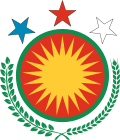This article needs additional citations for verification .(April 2016) |
The national symbols of the Kurds is a list of flags, icons or cultural expressions that are emblematic, representative or otherwise characteristic of the Kurdish people.
This article needs additional citations for verification .(April 2016) |
The national symbols of the Kurds is a list of flags, icons or cultural expressions that are emblematic, representative or otherwise characteristic of the Kurdish people.
| Image | Notes |
|---|---|
 | The Flag of Kurdistan is the national flag of the Kurds |
 | Party flag of TEV-DEM; informally represents the Autonomous Administration of North and East Syria |
 | Flag of the Kingdom of Kurdistan (1922–24) |
 | Flag of Republic of Ararat (1927–30) |
 | Flag of Republic of Mahabad (1946–47) |
 | Coat of arms of the Kurdistan Regional Government |
 | Coat of arms of Democratic Federal System of Northern Syria (Rojava) |
 | Coat of arms of Republic of Mahabad (1946–47) |
| Coat of arms of Republic of Ararat (1927–30) |